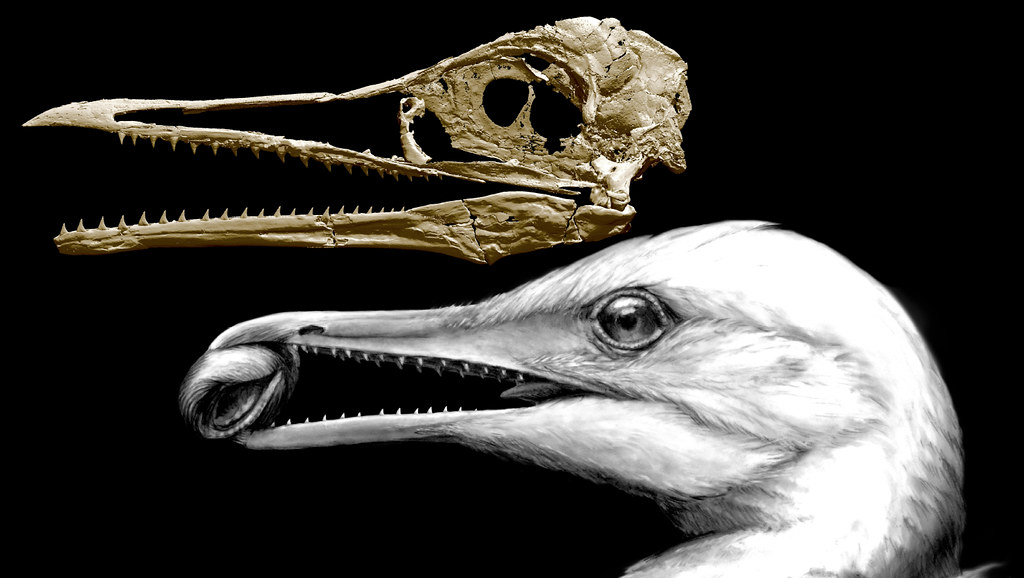An international team of researchers has pieced together the three-dimensional skull of an iconic, toothed bird that represents a pivotal moment in the transition from dinosaurs to modern-day birds. The team, including researchers from the Milner Centre for Evolution at the University of Bath, says the rare 3D fossil shows that the first bird beaks had teeth.
- Ichthyornis dispar lived around 86 million years ago in North America and was a similar size to a seagull
- First discovered in the 1870s, I. dispar is a key species in the transition from dinosaurs to modern birds
- Whereas most fossils are squashed flat, this is the first fossil of I. dispar with a skull preserved in 3D
- CT scans of the fossil shows insight into how modern day birds transitioned from the dinosaurs
Ichthyornis dispar drew the attention of such famous naturalists as Yale’s O.C. Marsh (who first named and described it) and Charles Darwin.
Yet despite the existence of partial specimens of Ichthyornis dispar, there has been no significant new skull material beyond the fragmentary remains first found in the 1870s. Now, a team led by Bath and Yale Universities reports on new specimens with three-dimensional cranial remains — including one example of a complete skull and two previously overlooked cranial elements that were part of the original specimen at Yale — that reveal new details about one of the most striking transformations in evolutionary history.
Dr Daniel Field, Prize Fellow at the Milner Centre for Evolution in the Department of Biology & Biochemistry, was joint first author on the paper with Michael Hanson of Yale University.
Field explained: “The fossil record provides our only direct evidence of the evolutionary transformations that have given rise to modern forms, but most fossils are squashed flat during the fossilisation process making it almost impossible to study the anatomy of the brain and details of the skull.
“This extraordinary new specimen reveals similar brain proportions to that of a modern bird, but other parts of the skull more closely resemble the skulls of predatory dinosaurs.
“In modern birds, the beak is made up of a small region called the maxilla and a larger area called the pre-maxilla. In contrast, the beaks of dinosaur-like early birds such as Archaeopteryx, which lived 150 million years ago, were mostly made up of the maxilla. The skull of I. dispar was a cross between the two and its beak had a large maxilla with teeth and small pre-maxilla.”
“Right under our noses this whole time was an amazing, transitional bird,” said Yale paleontologist Bhart-Anjan Bhullar, corresponding author of the study published in the journal Nature. “It has a modern-looking brain along with a remarkably dinosaurian jaw muscle configuration.”
Perhaps most interesting of all, Bhullar said, is that Ichthyornis dispar shows us what the bird beak looked like as it first appeared in nature.
“The first beak was a horn-covered pincer tip at the end of the jaw,” said Bhullar, who is an Assistant Professor and Assistant Curator in geology and geophysics. “The remainder of the jaw was filled with teeth. At its origin, the beak was a precision grasping mechanism that served as a surrogate hand as the hands transformed into wings.”
The research team conducted its analysis using CT-scan technology, combined with specimens from the Yale Peabody Museum of Natural History; the Sternberg Museum of Natural History in Fort Hays, Kansas; the Alabama Museum of Natural History; the University of Kansas Biodiversity Institute; and the Black Hills Institute of Geological Research.
Other co-authors of the study are David Burnham of the University of Kansas, Laura Wilson and Kristopher Super of Fort Hays State University, Dana Ehret of the Alabama Museum of Natural History, and Jun Ebersole of the McWane Science Center.
The researchers said their findings offer new insight into how modern birds’ skulls eventually formed. Along with its transitional beak, Ichthyornis dispar had a brain similar to modern birds but a temporal region of the skull that was strikingly like that of a dinosaur — indicating that during the evolution of birds, the brain transformed first while the remainder of the skull remained more primitive and dinosaur-like.
“Ichthyornis would have looked very similar to today’s seabirds, probably very much like a gull or tern,” said Hanson. “The teeth probably would not have been visible unless the mouth was open but covered with some sort of lip-like, extra-oral tissue.”
The research was supported, in part, by the University of Bath, Yale University, the Yale Peabody Museum of Natural History, the Alexander Wetmore Memorial Research Award, the Stephen J. Gould Award, and grants from the National Science Foundation, the Yale Institute for Biospheric Studies, the Evolving Earth Foundation, and the Frank M. Chapman Memorial Fund.
Daniel J. Field, Michael Hanson, David Burnham, Laura E. Wilson, Kristopher Super, Dana Ehret, Jun A. Ebersole & Bhart-Anjan S. Bhullar (2018) “Complete Ichthyornis skull illuminates mosaic assembly of the avian head” is published in Nature DOI: 10.1038/s41586-018-0053-y.

